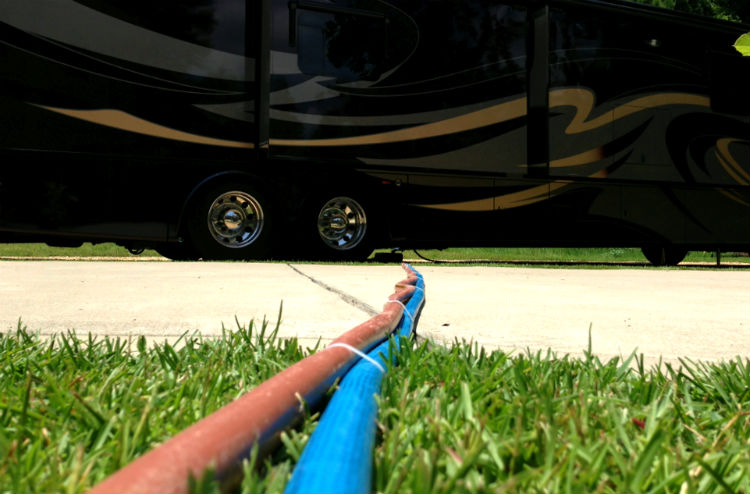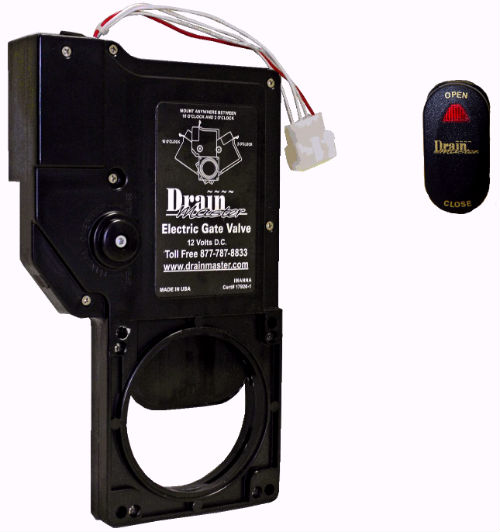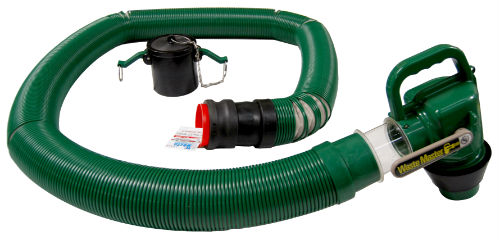Dumping the waste tanks is a necessary evil in the RV world. Long lines at dumping stations, working with cumbersome hoses, rinsing the plumbing, and the scary risk of leakage are just some of the many realities of completing this thankless task.

Photo courtesy of iRV2.com
“This a process that should be uneventful and in a lot of cases that I have seen over the years, it hasn’t been,” says Doug Swarts, owner of California-based Drain Master, manufacturer of the Waste Master Transfer System and the Drain Master Electric Waste Valve, designed to simplify the dumping process in a few easy steps. “For years the transferring of waste has always been a gray area in the RV industry and needed to be addressed more for RVers.”

Installation takes approximately one-hour and is designed to fit most RVs as it uses a little more space than manual valve systems.
The Drain Master Electric Waste Valve, which is designed to simply waste water dumping process, replaces manual or cable pull valves and operates on a 12V DC platform that can run on any house battery of an RV.
It simply attaches to the black and grey waste tanks, and electronically opens and closes a three-inch ABS gate valve at a lighting speed of less than one second. The system is operated via a control switch that can be mounted inside your RV, the plumbing bay, or both.
According to Swarts, to operate, simply take out the transfer hose, put it in the sewer inlet at the dumping station, open the nozzle lever, push the valve buttons on the control panel, and the system does the rest.
Featuring 303 stainless steel gears to provide optimum torque for the waste gate, the Drain Master Electric Waste Valve system is said to accommodate most pipe sizes and highlights a set of exclusive seals to ensure reliability against leakage or wear. In fact, during initial testing, Swarts explained the unit was trialed for 3,000 cycles, which is the equivalent to RVers dumping the tanks three times a week, 52 weeks of the year, for 19 years.
Other components in the Drain Master Electric Waste Valve System Kit Includes:
- LED operator switch with a five- amp inline fast blow fuse
- Mate-N-Loc connectors on all electrical wires
- A pre-mounted LED sensor on back of gate
- Dow 111 lubricant
“This was a system that was designed to withstand all the rigors of RVing and the outdoors environment,” said Swarts. “In the event of limited or no power, the valves can also be opened and closed manually.”
Ideal for serious do-it-yourselfers with minimal parts, installation is said to take approximately one-hour and is designed to fit most RVs as it uses a little more space than manual valve systems. For instance, it measures 10″ (w) x 6″ (h) x 1 3/4″ (d) and additional space may be required if RVers are installing 1 ½-inch piping.

The Waste Master Transfer System.
The Waste Master Transfer System highlights:
• Industrial-grade Cam Loc fittings
• Patented sewer hose design
• Convenient nozzle allows for shut off at the sewer inlet
• Clear view section indicates when the water is clear
For enthusiasts who stay at a campground for long periods of time (or full timers for that matter), Swarts explained that they can leave the hose attached to the system (depending on space in the plumbing bay), which greatly reduces and/or eliminates the common spillage of waste into the ground water and environment.
“The greatest single benefit of the system started with cleaning up the environment, which was one of the real key points of devising this,” said Swarts. The second part was the designing of a product that would withstand the rigors of commonly dumping the tanks repeatedly over a long period of time.”

Where is it and how much is it?
Hi Jerry,
You can view all the pricing, ordering info, options and details by visiting http://drainmaster.com/rv/
This “automates” the easiest part of the whole process, it does nothing about:
1. Managing long drain lines.
2. Ensuring drain hose remains attached to dump station inlet
3. Rinsing hoses after draining
4. Flushing tanks
5. Storing hoses
The photo implied that the solution was a macerating pump that can extend a long distance uphill from the RV, but that was not what the article was about at all.
Hi Thomas,
Thanks for the insight. The lead photo that was used for the story was basically representing the task of emptying waste tanks and was not intended or used to describe any one aspect or method of emptying the tanks. Otherwise, I hoped you liked the story, and if you have any other concerns please feel free to reach out to us.
A video would have been helpful and would have pricing information in the story. More information/instruction would make this better.
Hi Craig,
Thanks for your comments. I will be adding to the story that we are in fact in the process of doing a step-by-step how-to install feature of this system and the process in which it operates, which is required for such a system (as well as to further complement the story). The pricing and more details is supplied by a hot link in the story to the company, which is why we include these links so you can be provided with further details.
Hope this addresses your concerns.
Could you walk me through the math that shows that 3,000 uses is the same as 3 times a week for 36 years?
Hi Bruce,
Thanks for double checking our math! Based on the numbers in the article, the actual numbers would be 19 years at 3,000 cycles (if used three times a week). According to the manufacturer, many duration tests have been conducted including the recording of 25,000 cycles with the system still going strong.
And (regardless of our math skills), these numbers are pretty impressive when it comes to longevity and reliability for RVers on the road.
Thanks for pointing this out!
How does this do anything to simplify the dump process? As far as I can tell, it replaces a manual valve, which only needs to have the handle pulled to open and pushed to close, with an electrically operated valve which only needs a button pushed to open and again to close. It seems like there is no other change to the process. Let me tell you, opening and closing the valve is nowhere near the most annoying part of dumping; in fact, it is probably the LEAST annoying part.
Hi John,
I inquired to the manufacturer about your concern. There is a storage system available so the hose can be left connected to the RV at all times, which makes the dumping of holding tanks as simple as putting gas in your car (at certain sites) and they will have it on their website in the next week or so. The electric valves are more of a convenience, much like power windows or door locks in a car. The important part of having electric gate valves is the automated process of dumping the holding tanks and adding the proper additive when the process is complete.
While it may not be for everyone, it will certainly make the total process more sanitary and environmentally friendly.
Hope this helps!
How hard is it to pull out the handle of the manual dump valve? This thing is useless if that’s all it was used for.
There is a darker side… electrically-controlled dump valves have been used by some RV’ers to dump grey water (hopefully only grey) while driving along unpopulated stretches of road.
One can argue about what damage that does, but that’s the only value I could see this having. Which of course the manufacturer would never claim as a feature, even if it is the main one.
It’s very hard for me to do. I have to use my cane to open and close them and it’s painful just to walk to them and get down low enough to reach them, so appreciate your physical ability while you have it. When it’s gone you might say, “what happened?”
Thanks for a very informative story. I will be following the link for more information from the manufacturer. Good job!
Hi Jeff,
It’s our pleasure. We are glad you liked the story.
Sewer Solution! Best RV upgrade I ever did.
Great to Hear Bob.
And I was so naive to think there would be some helpful tips on dumping here…….. shame on me!!!
Please refer to some of the previous comments on this story. This system described in the article is designed to be installed and simplify the process, making it easier for RVers. However, thanks for the comment and please leave it to us and we will certainly work on an article pertaining to some tips on this thankless task!
Steve, nice article and thanks. I can see this valve and system being a real benefit for many people. And for folks who are complaining about this article, not everyone is under 40 and flexible, as for example my parents-in-law who are long in the tooth and still rv. The longevity test numbers are impressive.
I’m way over 40, not very flexible, long in the tooth, and still RV. This is a useless item:
1. Expensive, about US$225 plus installation.
2. Possible pollution: some idiot RVers will open the valve while they drive.
3. How hard is it to pull a valve?
It’s a solution for a problem that does not exist! Bah Humbug!